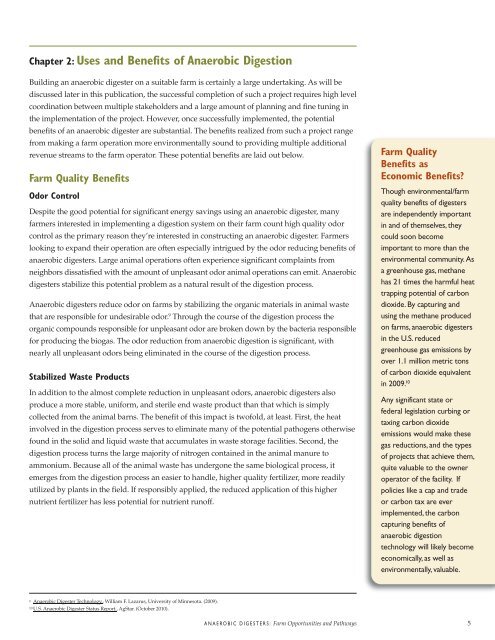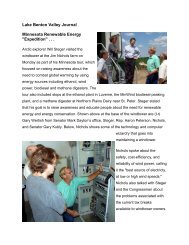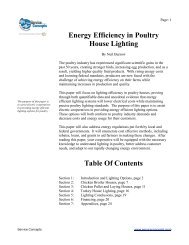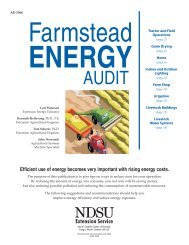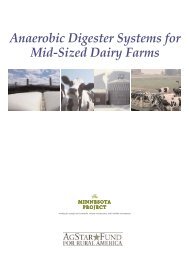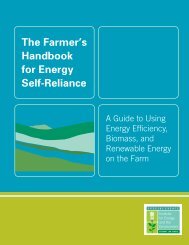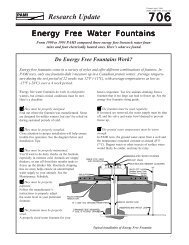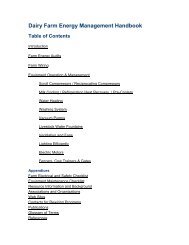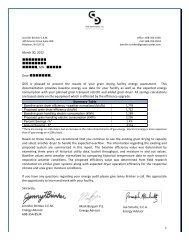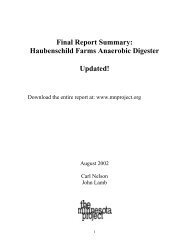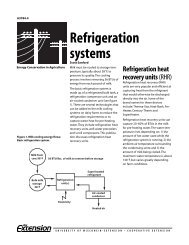Anaerobic Digesters - The Minnesota Project
Anaerobic Digesters - The Minnesota Project
Anaerobic Digesters - The Minnesota Project
You also want an ePaper? Increase the reach of your titles
YUMPU automatically turns print PDFs into web optimized ePapers that Google loves.
Chapter 2: Uses and Benefits of <strong>Anaerobic</strong> Digestion<br />
Building an anaerobic digester on a suitable farm is certainly a large undertaking. As will be<br />
discussed later in this publication, the successful completion of such a project requires high level<br />
coordination between multiple stakeholders and a large amount of planning and fine tuning in<br />
the implementation of the project. However, once successfully implemented, the potential<br />
benefits of an anaerobic digester are substantial. <strong>The</strong> benefits realized from such a project range<br />
from making a farm operation more environmentally sound to providing multiple additional<br />
revenue streams to the farm operator. <strong>The</strong>se potential benefits are laid out below.<br />
Farm Quality Benefits<br />
Odor Control<br />
Despite the good potential for significant energy savings using an anaerobic digester, many<br />
farmers interested in implementing a digestion system on their farm count high quality odor<br />
control as the primary reason they’re interested in constructing an anaerobic digester. Farmers<br />
looking to expand their operation are often especially intrigued by the odor reducing benefits of<br />
anaerobic digesters. Large animal operations often experience significant complaints from<br />
neighbors dissatisfied with the amount of unpleasant odor animal operations can emit. <strong>Anaerobic</strong><br />
digesters stabilize this potential problem as a natural result of the digestion process.<br />
<strong>Anaerobic</strong> digesters reduce odor on farms by stabilizing the organic materials in animal waste<br />
that are responsible for undesirable odor. 9 Through the course of the digestion process the<br />
organic compounds responsible for unpleasant odor are broken down by the bacteria responsible<br />
for producing the biogas. <strong>The</strong> odor reduction from anaerobic digestion is significant, with<br />
nearly all unpleasant odors being eliminated in the course of the digestion process.<br />
Stabilized Waste Products<br />
In addition to the almost complete reduction in unpleasant odors, anaerobic digesters also<br />
produce a more stable, uniform, and sterile end waste product than that which is simply<br />
collected from the animal barns. <strong>The</strong> benefit of this impact is twofold, at least. First, the heat<br />
involved in the digestion process serves to eliminate many of the potential pathogens otherwise<br />
found in the solid and liquid waste that accumulates in waste storage facilities. Second, the<br />
digestion process turns the large majority of nitrogen contained in the animal manure to<br />
ammonium. Because all of the animal waste has undergone the same biological process, it<br />
emerges from the digestion process an easier to handle, higher quality fertilizer, more readily<br />
utilized by plants in the field. If responsibly applied, the reduced application of this higher<br />
nutrient fertilizer has less potential for nutrient runoff.<br />
9 <strong>Anaerobic</strong> Digester Technology., William F. Lazarus, University of <strong>Minnesota</strong>. (2009).<br />
10 U.S. <strong>Anaerobic</strong> Digester Status Report., AgStar. (October 2010).<br />
Farm Quality<br />
Benefits as<br />
Economic Benefits?<br />
Though environmental/farm<br />
quality benefits of digesters<br />
are independently important<br />
in and of themselves, they<br />
could soon become<br />
important to more than the<br />
environmental community. As<br />
a greenhouse gas, methane<br />
has 21 times the harmful heat<br />
trapping potential of carbon<br />
dioxide. By capturing and<br />
using the methane produced<br />
on farms, anaerobic digesters<br />
in the U.S. reduced<br />
greenhouse gas emissions by<br />
over 1.1 million metric tons<br />
of carbon dioxide equivalent<br />
in 2009. 10<br />
Any significant state or<br />
federal legislation curbing or<br />
taxing carbon dioxide<br />
emissions would make these<br />
gas reductions, and the types<br />
of projects that achieve them,<br />
quite valuable to the owner<br />
operator of the facility. If<br />
policies like a cap and trade<br />
or carbon tax are ever<br />
implemented, the carbon<br />
capturing benefits of<br />
anaerobic digestion<br />
technology will likely become<br />
economically, as well as<br />
environmentally, valuable.<br />
ANAEROBIC DIGESTERS: Farm Opportunities and Pathways 5


